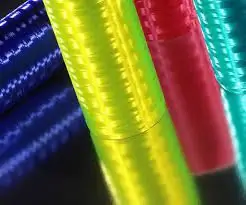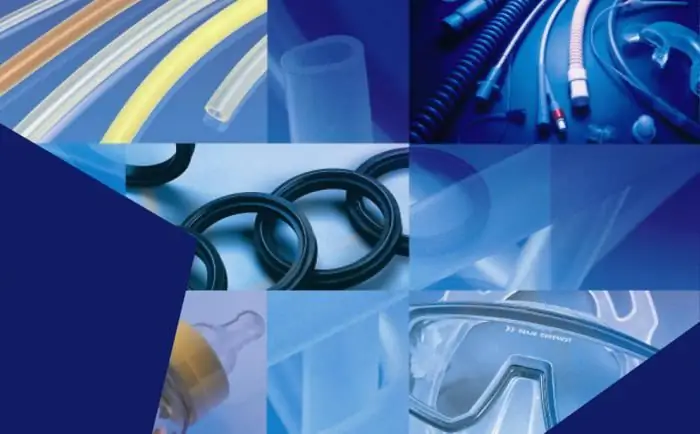2025 Author: Howard Calhoun | [email protected]. Last modified: 2025-01-24 13:10:45
Krasnoyarsk Synthetic Rubber Plant has been producing products since 1947, deliveries are made to 35 countries of the world. The production is more than 42 thousand tons per year, the range includes 85 brands of rubber. The company is among the top ten world leaders in the industry.
Discovery and development
In 1947, the Soviet government decided to build a synthetic rubber plant in Siberia. The city of Krasnoyarsk was chosen as the location. According to the development plan, the plant's products were intended for the needs of the country's military and industrial complexes in those areas where rubber types were required that were resistant to aggressive environments - solvents, lubricants, gasoline, etc. The foundation of the first workshops was laid in 1948, the production lines were launched in 1952.

The enterprise reached its full design capacity in 1956. After 2 years, the production volume amounted to thirty thousand tons per year. In 1960-1970The Krasnoyarsk plant of synthetic rubber replenished the line of the production base. New workshops were put into operation, where new types of products were produced. In the early 70s, several stages of reconstruction and modernization were implemented at the enterprise, which made it possible to transfer part of the technological processes to automatic mode.
One of the achievements of those years is the construction of biological treatment facilities that consolidated industrial and domestic wastewater from residential complexes and industrial facilities. Later, the Krasnoyarsk Synthetic Rubber Plant JSC transferred them to the balance of the city.
Production expansion
In the mid-1970s, some of the outdated production facilities were closed at the enterprise and several more stages of modernization were carried out, which made it possible to increase the production of nitrile rubbers to one hundred thousand tons a year. In parallel with the increase in production volumes, the enterprise faced the issue of environmental protection.
In the next decade, the Krasnoyarsk synthetic rubber plant abandoned harmful technological processes, gradually switching to the use of biodegradable emulsifiers. In 1985, the shop for the production of nekal, which had been used since the founding of the plant for the synthesis of rubbers, was completely liquidated.

By 1987, production capacity was increased, the main products of the plant were nitrile rubber with improved technological properties, produced in a wide range. The total volume of products marked by high quality indicators,amounted to more than one hundred thousand tons per year, which made the Krasnoyarsk synthetic rubber plant one of the world leaders in terms of nitrile rubber production.
In 1990, in order to expand the range of products, the plant planned the construction of several workshops and production lines. Part of the capacity was intended for the production of a line of consumer goods. Due to the collapse of the USSR, the plans were not implemented. A rapid decline in production began.
In new conditions
Krasnoyarsk Synthetic Rubber Plant is an open joint stock company, the enterprise received this status in 1993. Despite this transformation, production was significantly reduced, almost 70% of the capacity was mothballed. By the end of the 1990s, part of the shops and lines were no longer subject to restoration. The plant was saved by joining the SIBUR holding.

Accession to an international company allowed to establish the supply of raw materials and the marketing of finished products. In 2011, after signing a cooperation agreement with the Chinese company Sinopec, joint ventures were opened in Shanghai and Krasnoyarsk, the main products being nitrile rubber.
Modernity
At the present stage of development, KZSK specializes in the production of nitrile rubbers. The total capacity of the enterprise is 42.5 thousand tons of finished product per year. The plant produces a powder type of rubber, the capacity of this line is 500 kilograms per hour. finished productenjoys constant demand from domestic and foreign enterprises. About 70% of all rubber is consumed by China, the remaining 30% is supplied to the domestic market, as well as to the UK, India, Turkey, the USA and other countries.

The products of Krasnoyarsk Synthetic Rubber Plant JSC have a special purpose, their consumers are enterprises producing cable products, asbestos products for technical purposes and rubber products. The plant is the only specialized production company in Russia, the share in the world output of this type of product is 6.2%. At the present stage, KZSK has mastered the production of 85 grades of rubber.
Production
According to the results of last year (2017), the Krasnoyarsk Synthetic Rubber Plant (TIN 2462004363) produced 38.5 thousand tons of products. Work was carried out to modernize production facilities aimed at improving the efficiency of equipment and production lines, developing personnel, improving safety and other areas of core activity.
New equipment was put into operation at the nitrile rubber separation site, in particular, recuperators were installed, a new refrigeration unit was installed, raw material storage tanks were replaced.

Also last year, the OPTs of the Krasnoyarsk Synthetic Rubber Plant produced prototypes of new product brands:
- Cross-linked (used in the production of seals, PVC films).
- Fast-curing (used for casting products).
- Nitrile carboxylate butadiene latex (used in the manufacture of technical gloves).
The plant has the following capacities:
- Six workshops for the production of the main product.
- Refrigeration shop.
- Auxiliary materials workshop.
- Pump station for monomer supply.
- Auxiliary production shops.
- Transport sections.
- Repair shops (construction, mechanical repair, instrumentation and A, electrical shop).
- Storage tanks (ground for ammonia, butadiene and acrylonitrile; underground for petroleum products).
- Warehouses for storing finished products.
Some of the production facilities are in a state of conservation.
Products
Krasnoyarsk Synthetic Rubber Plant has retained its leadership position in the domestic market and is a full-cycle enterprise. The company is in the TOP-10 leaders in the production of rubber in the world.

Main types of rubbers:
- Butyl rubber.
- Isoprene.
- Emulsion styrene-butadiene.
- Solution styrene-butadiene.
- Butadiene-nitrile.
- Thermoplastic elastomers.
The infrastructure of the enterprise allows for a full cycle of loading and unloading operations, storage, withoutattraction of partner organizations. KZSK has at its disposal its own overpasses (draining of raw materials, shipment of the finished product), access roads (railway, auto), warehouses for storing raw materials and all types of rubbers. The main supplier of raw materials is the Tobolsk-Neftekhim company, which is part of the SIBUR holding.
Product Applications
KZSK produces products needed for many industries, namely:
- Rubber products intended for use in aggressive environments (high-pressure hoses, cable sheaths, seals, gaskets, conveyor belts, washers, seals, rings, plugs, adhesives, etc.).
- Tyre production (sidewalls, carcass, tread, belt).
- Manufacture of auto and bicycle inner tubes.
- Road construction (improvement of bituminous mixtures).
- Adhesives (adhesive tapes, adhesives for footwear, furniture, building materials, etc.).
- Paper production.
- Oil industry.
- Some grades of nitrile rubber are used in food packaging, industrial seals, etc.
- Powdered rubber improves the quality and performance of many types of adhesives, shoes, mastics, PVC products. Also, this type of product has found application in the production of asbestos products for technical purposes (fractional overlays, oils, etc.).
- Drive belts.
- Construction industry (production of waterproofingmaterials, paints, waterproof wallpaper, etc.).
- Rubber fabric materials.
- Medical industry (warmers, blood transfusion tubing, balloon products, tourniquets, etc.).
- Light industry (production of floor coverings and oilcloths, production of artificial fur and leather, fur processing, spinning, etc.).
- Consumer goods (sports and travel goods, household chemicals, diving products, gaskets for household appliances, etc.).
- Shoe manufacturing (soles, rubber shoes, impregnations for waterproof shoes, etc.), etc.
KZSK continues to increase production volumes and develop new recipes.
Recommended:
Synthetic fibers. Synthetic polyamide fiber

Synthetic fibers began to be produced industrially in 1938. At the moment, there are already several dozen of them. All of them have in common that the starting material for them is low molecular weight compounds that are converted into polymers through chemical synthesis. By dissolving or melting the resulting polymers, a spinning or spinning solution is prepared. Fibers are formed from a solution or melt, and they are only then subjected to finishing
Synthetic accounts. Synthetic and analytical accounts, the relationship between accounts and balance

The basis for monitoring and analyzing the financial, economic, investment activities of an organization are accounting data. Their reliability and timeliness determine the relationship of the enterprise with regulatory authorities, partners and contractors, owners and founders
Polymers in our daily lives: synthetic rubber

Synthetic rubber plays a very important role in human life. It is found in almost all sectors of our life: from dishes, toys to the automotive industry and rockets. There are two main categories: speci alty rubbers and general purpose rubbers. And each of these categories has its own unique uses
How synthetic isoprene rubber is made

Natural rubber has many analogues, and isoprene rubber is considered one of the most large-tonnage. The industry produces a wide variety of types of these products, differing both in properties and in the type of catalysts that were used - lithium, complex, and the like
Rubber tiles: production from A to Z. List of required equipment and market overview

Rubber tiles, which can be produced independently, must be made according to a certain technology. This material appeared on the building goods market relatively recently. However, it can be noted that although this production is not widespread, it has good prospects

